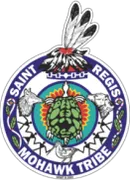Explored Partnership to Combat Diabetic Related Amputations
Photo: Cuban Medical Services Commercial Center: Left to Right, Dr. Jose J. Portilla, International Relations, Interpreter from International Relations, Chief Eric Thompson, Chief Beverly Cook, Michael Cook, SRMT Health Services Director, Dr. Jorge Alberto Mirando Quintana, Presidente, Commercialization of Services, responsible for Medical Tourism Program, Dr. Joe Robinson, SRMT Health Services Physician, Jose Barreiro, National Museum of the American Indian, Smithsonian Institution, Katsi Cook, elder Aboriginal Midwife, representative of the NoVo Foundation.
Akwesasne, NY—The historic diplomatic relationship between Cuba and Akwesasne has been honored by a representation of leaders on a mission to learn about Heberprot-P, a treatment developed by the Cuban National Institute of Endocrinology that is 78% effective in preventing amputations related to diabetic foot ulcers. The week of Onerahtóhka/April 25 through Onerahtóhka/April 29, 2016 included an aggressive schedule to visit fourteen health facilities, discuss international relationships between Nations and develop a mutual understanding of healthcare services and delivery models. The Saint Regis Mohawk Tribe’s delegation included Chief Eric Thompson, Chief Beverly Cook, Family Nurse Practitioner, Michael Cook, Director of Health Services, Joe Robinson, MD, SRMT Health Services, Katsi Cook, elder Aboriginal Midwife and researcher who traveled with the medical delegation as a representative of the NoVo Foundation’s Indigenous Communities Program, and Jose Barreiro of the National Museum of the American Indian, Smithsonian Institution, Washington, DC. The diverse expertise of the group shed light on the historical parallels between the cultures of the people of Akwesasne and Cuba and captured the respect of the officials with the Ministry of Public Health, their physicians who graciously shared their time and the scientific leaders of the biotech institute responsible for the commercialization of their medicine. Cuba’s public health system provides universal care for their 11 million residents, 660,000 of whom are fighting diabetes.
The tour commenced at the headquarters of the Ministry of Public Health, where the Director of International Relations greeted the delegation and presented an explanation of the Cuban National Health System, referred to as, Doctor and Nurse of the Family. Policlinics, the equivalent of primary care practices with extensive services, are in strategic provincial locations. They’re the entryway into a three-tier healthcare delivery system. The secondary level of care is provincial hospitals and the third, or tertiary level includes research centers. Primary care clinics have a family practitioner that lives and works in the same building and is an integral part of the community. “I was impressed by the simplicity of their facilities compared to what we have in the States but what struck me was the expectation for physicians to be embedded in the communities,” remarked Chief Beverly Cook, “Physicians are tasked with being more available to the people and I think that’s a tremendous positive step they’ve instituted. Their model stresses prevention; it’s a powerful way to approach healthcare. Their diabetic patients facing amputation have a treatment and medical models that we don’t currently have but will definitely be seeking.”
The Cuban Biotechnology Institute responsible for developing Heberprot-P rival’s global pharmaceutical companies in research and development. “Even if this medication makes it through clinical trials in the U.S., there is no guarantee the treatment will be available to Indian people who would benefit from it. People may not have adequate health insurance or in some cases Indian Health Services’ budget may not allow for it. As leaders, we are obligated to find a solution to this serious problem,” said Chief Cook. The delegation met with the Director of the National Institute of Endocrinology, the Anti-Diabetic Center and Cuban Medical Services to learn about the treatment and understand the medical tourism model that may connect people in dire need of treatment access to care, internationally with a longer-term plan to train SRMT providers in Cuba to bring the treatment to Akwesasne.
The most recent statistics from SRMT Health Services reveal half of the community members in Akwesasne over the age of 65 are diabetic. In a study published by the American Diabetes Association, the incidence of lower-extremity amputation in “American Indians” with diabetes is 4.4%.[1] Michael Cook expressed, “healthcare cannot be a static process. We need to evolve. A small part of our tour included walking in on a group of people discussing their life and disease. They didn’t know each other coming in, but by sharing, they showed one another there is hope. Our diabetes program is at the stage where we need to be prepared to evolve to the next phase. We are evolving into a prevention model. We are giving our community members tools to maintain healthy lifestyles. This tour gave us a stark reminder of the importance of prevention and when patients are past that stage, there is hope, there is a treatment and it’s our job to find a mechanism to provide access.”
“The prevalence of diabetes in our community is what prompted this visit,” shared Chief Thompson. “We had an opportunity to investigate Heberprot-P and its accessibility. It was incumbent upon us to do so for the simple reason of saving our people from unnecessary pain. The key is accessibility and overcoming political barriers. As Tribal leaders, we are responsible for taking care of our families,” expressed Chief Eric Thompson. Referring to essential diplomatic relation building, he stated, “Our visit is in step with the best traditions of our people. The weight of the occasion is not lost on me. It’s very humbling, as a representative of the people, to engage with the Cuban people.”
For more information, please look forward to subsequent coverage from Akwesasne TV, as a presentation at the next Monthly Tribal Meeting scheduled for Saturday, Onerahtohkó:wa/May 14, 2016. News coverage of this delegation’s visit will also be shared with national media and at national Indigenous leadership events. Physicians and providers caring for Indigenous people have been invited to attend the International Congress: Controlling Diabetes and Its Main Complications in Varadero, Cuba in December of 2016.
#####
[1] Resnick, Helaine E., PhD. "Incidence of Lower-Extremity Amputation in American Indians." DiabetesJournals.org. American Diabetes Association, Aug. 2004. Web. 3 May 2016.
--------------------------
Photos showing the evolution of diabetic fool ulcer treatments using Heberprot-P.

Physician at the Anti-Diabetic Center explaining the Heberprot-P treatment to the Mohawk Delegation. He treats 15 patients each day on an outpatient basis.

Photo of the 6 grades of diabetic foot ulcers, as classified by the Cuban National Institute of Endocrinology. Grades 5 and 6 are treated in the hospital. Grades 2-4 are treated at the Anti-Diabetic Center.

Cuban Medical Services Commercial Center: Left to Right, Dr. Jose J. Portilla, International Relations, Interpreter from International Relations, Chief Eric Thompson, Chief Beverly Cook, Michael Cook, SRMT Health Services Director, Dr. Jorge Alberto Mirando Quintana, Presidente, Commercialization of Services, responsible for Medical Tourism Program, Dr. Joe Robinson, SRMT Health Services Physician, Jose Barreiro, National Museum of the American Indian, Smithsonian Institution, Katsi Cook, elder Aboriginal Midwife, representative of the NoVo Foundation.

Heber Biotec Department of Strategic Products and Government Programs: Delegation with Manuel Raices Perez-Castaneda, PhD.
Casa de Las Americas: Mohawk cultural presentation and Public Program with Cuban Indigenous Program
# # # #
Please direct media inquiries to the Communications Department at (518) 258-2272.

